HARE AND HERL
This is a pattern I came up with and is doing very well at catching trout for me. I am very fond of Peter Frailey's Web site and his "Hare & Herl Bugger" and his pattern inspired me to try this. It is not a difficult pattern to tie up. You will notice in the step-by-step tying instructions that I tie in "reverse" and you can tie it whichever way best suits you.
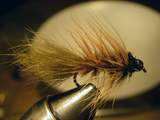
Materials:
- HOOK: Mustad #12 - 9671
- THREAD: UNI 8/0 in black
- WEIGHT: 7/64th Tungsten bead and .020 lead wire
- TAIL: Olive Rabbit Fur
- BODY: Black Ostrich Herl
- HACKLE: Conrach JV Hen in brown/tan

This is the hook with Tungsten bead and 4-5 wraps of .020 lead wrapped on hook shank behind bead and pushed up into bead. Overwrap with tying thread and run thread to rear of hook.
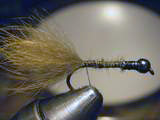
Cut a pinch of Olive Rabbit fur from hide, remove under fur and tie in for tail. Save the unde rfur for making some great rabbit dubbing.
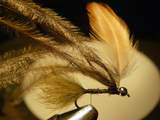
Run thread to behind the bead and tie in 6 black ostrich herls and the hackle and then run thread to the rear tie-in point.
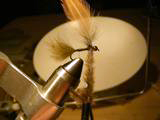
Grip the ostrich herls together with electronic clips or hackle pliers (whichever you prefer) and twist them together to form ostrich herl chenille.
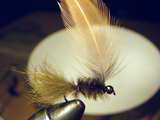
Wrap the ostrich herls to the rear and tie off at the tail tie-in point and clip off excess.
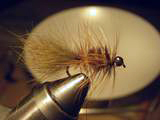
Next grasp the hackle and palmer it through the body to the rear and tie off and clip the excess.

Now run your thread through the body to the front behind the bead. When tying in reverse like this, you do not have to reverse wrap your thread to cross over the hackle. Continue wrapping forward and zigzag your tying thread back and forth so not to trap any hackles down. Once to the front, build a small head to push the hackle back and then tie in 2 more black ostrich herls and wrap them over your thread wraps and then whip finish and apply head cement.
I hope you have as much success with this pattern as I do and I apologize for the poor quality of the pictures and hope the tying instructions are clear. If not, please let me know.
Warren Patterson (WarrenP)
Tennessee
For more great info, check out:
Beginning Fly Tying | Intermediate Fly Tying | Advanced Fly Tying.
